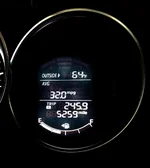If you are pushing wide, it's because you are going too fast for the conditions, your tires are crap or you aren't skilled enough in winter driving, not because you have a 2.5L and can't produce as much grip in a corner. Sure there are advantages to having a lighter front end, but they are pretty insignificant to other factors in those conditions.
I'm going to be blunt and be brutally honest here when I say that's a really stupid thing to say. Let me fix it for you by simplifying it.
If you are pushing wide, you are going too fast for conditions. Period. It doesn't matter if your tires or driving skills suck, you're simply going too fast if you're not able to keep it in your lane. But here's the part you confuse. If you have better tires, more driving skill or a car that has less tendency to push wide, the safe speed for conditions becomes higher. Which means if traction is suddenly reduced, the car with better tires or more balanced handling has a larger margin of safety. Your view neglects this all important fact. And yes, the extra 112 pounds of the bigger motor in the engine bay is a distinct disadvantage under low traction conditions, particularly when there is only one or two occupants and little cargo. Anyone who says differently doesn't have a clue.
I would rather have the extras bhp and torque to get me out of bad situations. One advantage is having more torque gives you a better chance to use a higher gear and reduce wheel spin when climbing a steep ice cover hill. I wouldn't want to use 2nd or 3rd to get up a hill with a foot of snow on it, would rather have the larger engine with more torque and use a higher gear.
That is just plain wrong and I will explain exactly why it's wrong if you're willing to be open-minded and learn something new rather than repeating common fallacies and half-baked ideas.
The entire reason a skilled driver might prefer a higher gear (over a lower gear) to climb steep ice is because the higher gear reduces torque to the drive wheels. In a marginal traction situation the reduced torque can make it easier to maintain traction rather than spinning the tires up. The smaller 2.0L engine has reduced torque to begin with so there is less need to shift to a higher gear to avoid excessive torque to the drive wheels. And yes, this is not just theoretical knowledge it's from decades of snow driving experience in at least 30 different vehicles (my employers, my own vehicles and an occasional rental or borrowed vehicle). Regardless of engine torque, you simply select a gear that provides marginal torque. Thankfully, both the 2.0L and the 2.5L have broad, flat torque curves so neither engine has any particular advantage in this respect. And, in traction limited situations, you will NEVER need more power than the 2.0L engine can provide. Excessive power is never an advantage when your primary challenge is lack of traction.
What is of great benefit to snow/ice traction in terms of engine/drivetrain configuration is a lack of rotating mass. Too much mass wants to stay in motion for too long. When a wheel does break loose and start to spin, it's quicker and easier for it to regain traction if it's lighter. That's why I have my winter tires mounted on my much lighter aftermarket wheels. They hook-up and regain traction easier than the heavier wheels. The advantage of less rotating mass extends beyond the wheels to the
engine itself. This is one additional area where the 2.0L engine is better in traction limited situations. The 2.5L requires twin balance shafts running the length of the engine underneath the crankshaft. These shafts spin at twice the engine rpm and add a considerable amount of gyroscopic effect that just doesn't exist on the 2.0L engine.
From a practical standpoint, they are both excellent snow cars and, equipped with winter tires, either one is going to get you where you're going. But the 2.0L does have the edge. All this means is that if you were to race both vehicles on an icy, traction limited course with twists and turns, with equal drivers and tires the 2.0L would be faster (primarily due to the better weight distribution). Or, looked at another way, in an unexpectedly treacherous situation, the 2.0L would have a little more margin of safety.
Last edited:

